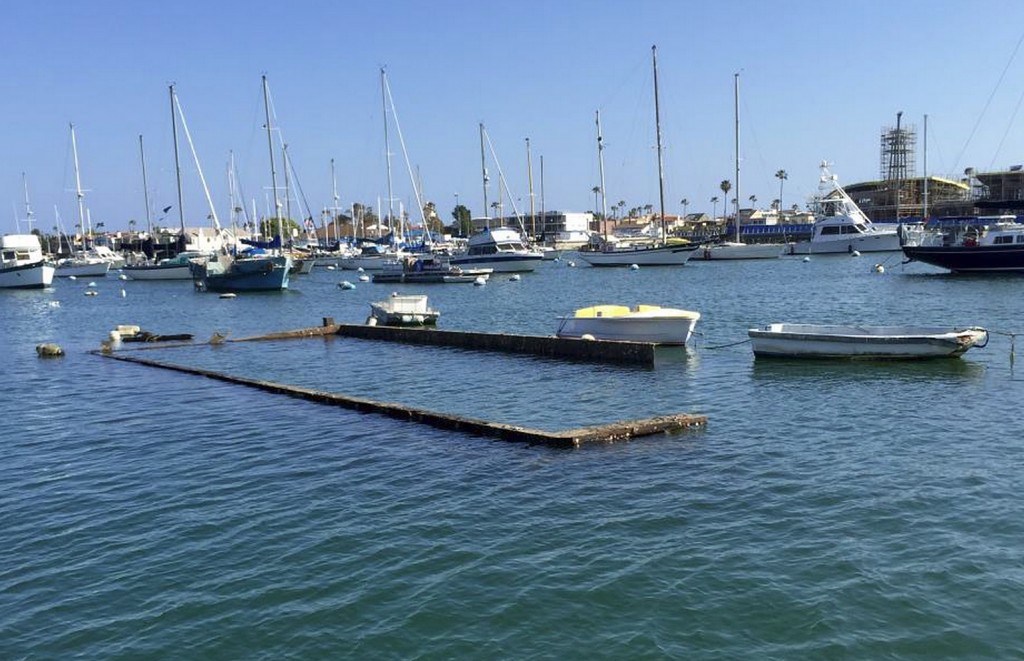
— Photo courtesy the city of Newport Beach ©
The sunken Shellmaker scow will soon be above water and out of Newport Harbor.
The Gemini scow sunk in July 2013 under mooring J-98, off the tip of Lido Peninsula and the south west shores of Lido Isle. Buoys mark off the area where it currently sits underwater. The top portion of the vessel is visible during low tide.
It should be removed “any week now,” said Harbor Resources Manager Chris Miller.
Best case scenario, work to raise the sunken scow could start in three to four weeks, Miller said. The outside time frame would be a few months.
“We expect to have it completed by the end of March, although it may happen earlier,” confirmed Paul Gillen, president of Associated Pacific Constructors, Inc., the marine construction company tasked with removing it.
The project will take a few weeks to complete, he added.
“It’s great for the harbor that we’re getting it removed,” said Harbor Commission Chairman Dave Girling. “It’s a great solution for everybody.”
Associated Pacific Constructors made a deal with Shellmaker, Inc., to remove the Gemini in return for two moorings transferred to APC, including the mooring where it sank, Gillen said. Lisa Miller, President of Shellmaker, Inc., confirmed the deal but declined to comment further.
“I was really glad they were able to work out a deal,” Miller said.
The barge that is going to be used to dispose of it will be based at that mooring, Gillen said.
APC will start by pulling a work barge alongside it, Gillen explained. Gemini will then be cut it into pieces that they can lift out of the water and place on the deck of the barge. They have to break it into manageable chunks, Miller said.
It will then be transported to the port of Los Angeles either by boat or by heading up Rhine Channel, loaded onto trucks and driven there. The transportation method may be an economic decision based on what other work they have in the harbor, Gillen noted.
“Either way it’s going to be lifted out of the water and disposed of at a recycling facility,” he said.
The project should not impact any of the navigational traffic during the operation, since the scow is sunk under its own mooring, Gillen said. The noise should be minimal since most of the work will happen underwater, he added.
The company will use the normal best management practices, which includes containing the area that they are working within so that nothing can float away, Gillen noted.
Shellmaker built the Gemini for small dredging projects in the harbor, Miller said, but they got out of the dredging business about a decade ago. The scow sat unattended and went into disrepair.
It was just weeks away from being scuttled (cleaned out and deliberately sunk) by the Coast Guard. It had been completely prepped and all the pumps, hydraulics, and fluids had been removed before it sunk in the harbor, Miller said.
“So all it was (when it sunk) was a steel hull with nothing else on it,” Miller said, “just a shell.”
For a few months in 2013, the side of the Gemini was still visible as it stuck out above the water.
Shellmaker made plans in fall of 2013 to patch any holes and raise it to the surface to continue the process to be scuttled. It proved to be too huge of a task because of the weight of the vessel and the expense of removal.
If it was a sailboat or another manageable boat, it would be easier to lift, Miller said. The scow weighs about 147 tons or roughly 300,000 pounds, he noted.
“It’s not something that can be easily done,” Miller said.
In fall of 2014, Shellmaker cut off several small pieces, but was unable to complete the job.
About 15 percent of it already removed by Shellmaker, Gillen confirmed.
Shellmaker had a hard time trying to remove it because of the expense, which could be as much as $100,000, Miller noted.
The city has received numerous complaints from harbor users about the scow.
“We worked with (Shellmaker) to try and find other solutions,” Miller said.
The derelict boat grant funds the city received from the state are not applicable for commercial vessels.
When APC came to the table they struck up a deal that worked for everyone, Miller said.
Both Shellmaker and APC have been working with the city to help get it done as expeditiously and efficiently as possible, Girling added.
“We’re thankful for Lisa Miller and the rest of her team at Shellmaker for their cooperation,” Girling said. “It shows how citizens and businesses and the city can come together with a common goal in mind and find a solution.”




